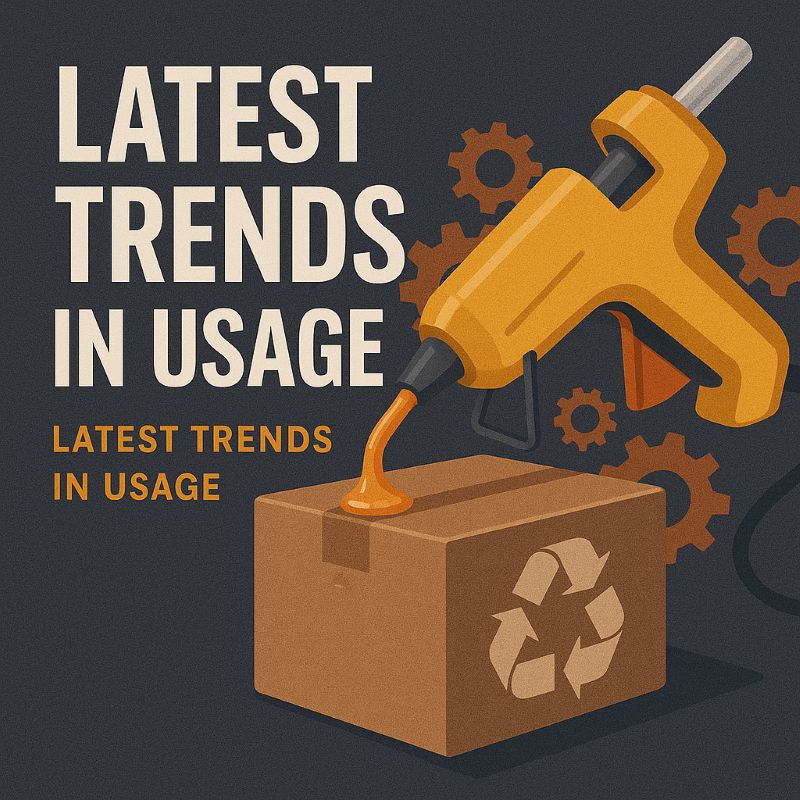
Hot Melt Adhesives Defined
Types of Hot Melt Adhesives
Importance in Manufacturing
Application Methods Explained
Latest Trends in Usage
Industry-Specific Strategies
Future of Hot Melt Adhesives
Frequently Asked Questions (FAQ)
Hot melt adhesives are versatile bonding agents widely used across various industries due to their fast-setting properties and strong adhesion. These thermoplastic adhesives are applied in molten form and solidify upon cooling, forming robust, long-lasting bonds. Common applications include packaging, bookbinding, automotive, woodworking, and textiles. High-performance variants are designed to ensure reliable bonding, clean dispensing, and compatibility with both manual and automated systems.
Hot melt adhesives are categorized by their base polymers, each offering specific advantages depending on the industry and application:
EVA (Ethylene-vinyl acetate): Cost-effective and reliable for packaging and paper-based applications.
Polyolefin: Offers excellent chemical and heat resistance, ideal for automotive and high-temperature environments.
Polyurethane (PUR): Flexible and strong, making it well-suited for textiles, wood, and complex assembly.
Reactive Types: Designed for durable, moisture-curing bonds under challenging conditions.
These types provide tailored solutions to meet diverse bonding requirements across various production settings.
Hot melt adhesives play a pivotal role in manufacturing by enhancing speed, productivity, and material compatibility. Their quick-setting nature reduces processing time and supports high-throughput operations. Industries such as packaging, textiles, and automotive rely on these adhesives to ensure durable bonds between various materials—ranging from plastics to textiles and metals. Their adaptability to different production speeds and substrates makes them indispensable for efficient, consistent output.
Choosing the appropriate application method is key to maximizing the performance of hot melt adhesives:
Roll Coating: Ensures even coverage for flat surfaces in packaging and textiles.
Extrusion: Used for precision bonding in automotive and engineered components.
Spraying: Ideal for irregular or large surface areas requiring flexible coverage.
Slot Die Coating: Offers controlled, high-precision application, especially in electronics and medical sectors.
Selecting the correct application technique reduces waste, enhances bond integrity, and supports streamlined production.
The hot melt adhesive sector is evolving rapidly in response to environmental and technological shifts:
Eco-Friendly Formulations: Bio-based and low-VOC adhesives are gaining traction in response to sustainability goals.
Automation: Integration into robotic and high-speed assembly lines increases accuracy and reduces waste.
Smart Adhesives: Responsive adhesives that adapt to environmental factors (e.g., humidity or temperature) are emerging.
These trends reflect an industry shift toward more intelligent, efficient, and environmentally conscious adhesive systems.
Different sectors require specialized adhesive performance:
Packaging: Demands fast-setting adhesives that support continuous production and clean bonding.
Automotive: Requires adhesives that resist heat, vibration, and chemicals over long-term usage.
Textiles: Prefers flexible, soft-bond adhesives that can handle dynamic stresses.
Woodworking: Needs strong, cleanly applied adhesives that hold well under pressure and temperature variation.
Choosing adhesives tailored to the unique stresses of each industry ensures optimal output and product quality.
As manufacturing evolves, hot melt adhesives are expected to play an even more critical role:
Sustainable Development: Future adhesives will prioritize recyclability, reduced carbon footprints, and compliance with global regulations.
Smart Integration: Adhesives will increasingly integrate with sensors and automation systems to provide real-time performance feedback.
Material Compatibility Expansion: New formulations will offer stronger adhesion across lightweight composites, advanced plastics, and even bio-based materials.
This ongoing innovation will support smarter factories, greener processes, and broader material design freedom.
Q: What are hot melt adhesives?
A: Thermoplastic adhesives that are applied hot and solidify on cooling, offering fast, durable bonding.
Q: What types of hot melt adhesives exist?
A: Common types include EVA, polyolefin, polyurethane, and reactive adhesives—each suited for different applications.
Q: Why are they important in manufacturing?
A: They reduce curing time, improve workflow efficiency, and offer strong bonds across various materials.
Q: What application methods are used?
A: Techniques include roll coating, spraying, extrusion, and slot die—each selected based on application needs.
Q: What are the latest industry trends?
A: Sustainability, smart formulation, and automation compatibility are major innovation drivers.
Q: How do industries benefit from hot melt adhesives?
A: Adhesives are tailored for specific needs—e.g., fast application in packaging, heat resistance in automotive, and flexibility in textiles.
Q: What should I look for in a high-performance adhesive?
A: Consider cure speed, temperature resistance, clean application, and compatibility with your production method.
Q: What’s the future of hot melt adhesives?
A: Trends point toward greener, smarter, and more versatile adhesives that support modern manufacturing demands.